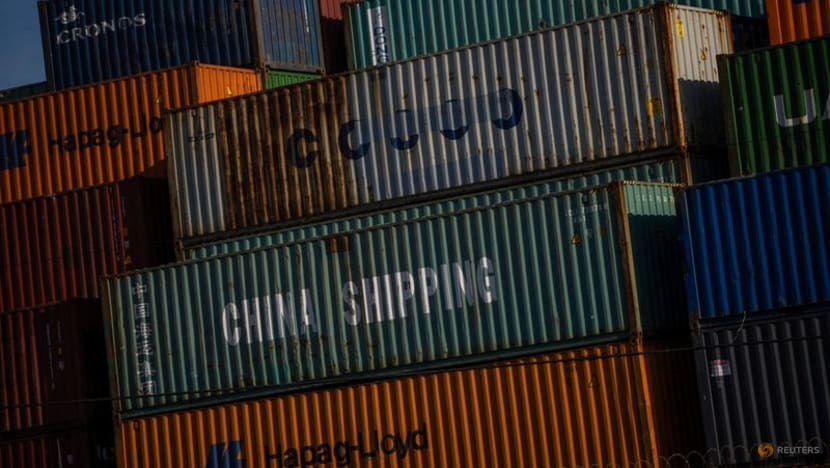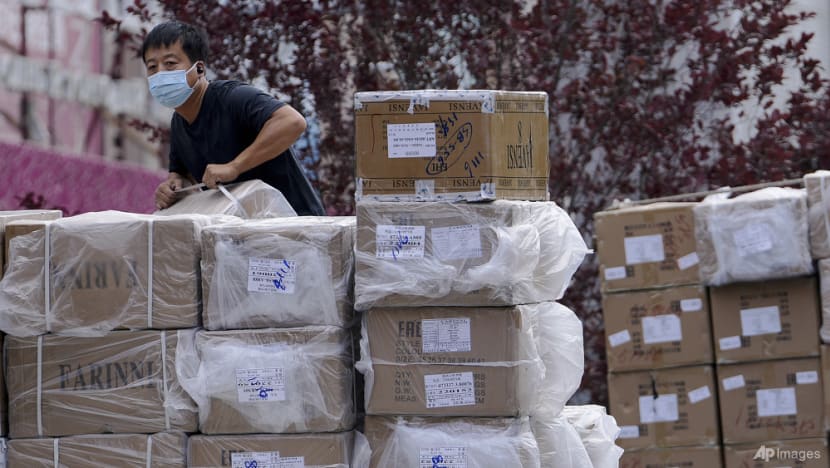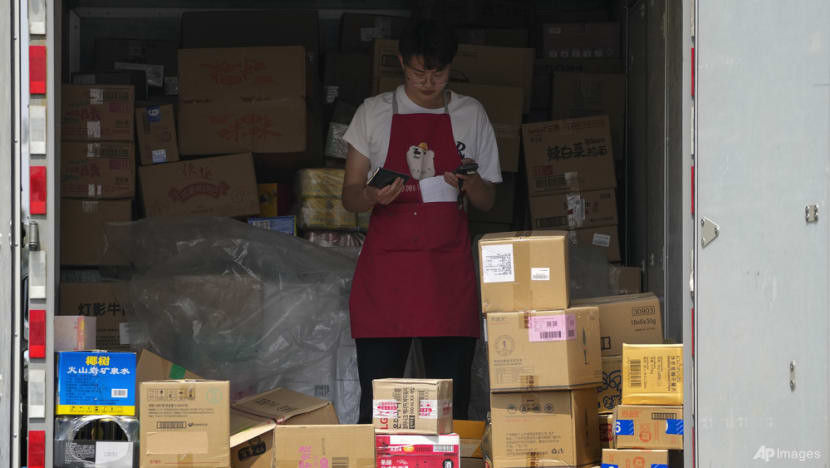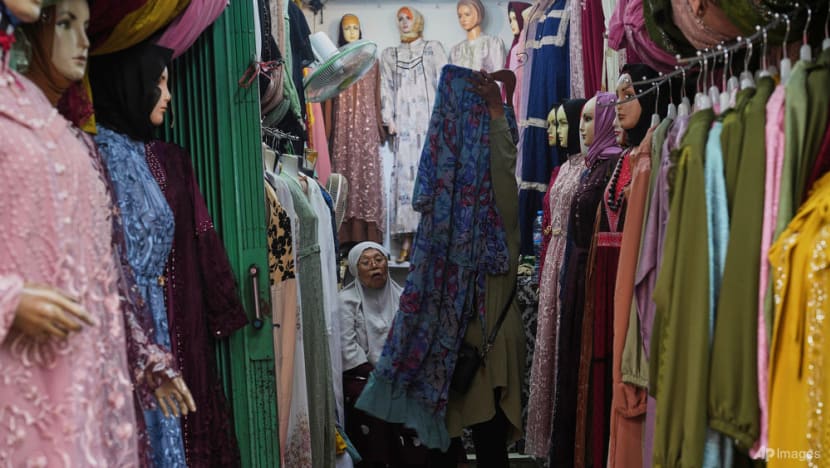China Power: How Trump’s tariffs could deepen Beijing’s regional sway, and what might stand in its way
As part of a series on China’s regional influence, CNA examines how Beijing's sway in Southeast Asia might change as US President Donald Trump's tariffs shock the region.


This audio is generated by an AI tool.
SINGAPORE: At a time when Southeast Asia is reeling from the shock of punitive US tariffs, a Chinese president is set to visit the region, having just promised at a rarely held conference back home to enhance ties with China’s neighbours.
Analysts say the stage seems set for China to deepen its regional sway as trust and confidence among Southeast Asian nations in the United States come under threat, especially amid President Donald Trump’s unpredictable policies and stance on the trade war.
The policy ping pong continues.
Beijing on Friday (Apr 11) announced it would raise tariffs on US goods to 125 per cent - up from 84 per cent - effective Saturday.
The move came just days after Washington on Apr 9 announced a 90-day pause on “reciprocal” tariffs on nearly all major trading partners - except China. Instead, he upped the stakes, raising levies on many Chinese imports to 145 per cent, an increase from 104 per cent.
Even countries spared the steepest tariffs now face a 10 per cent “universal” rate - and a climate of deepening uncertainty.
The latest escalation has unsettled Southeast Asia, where analysts say governments are reassessing risks and reviewing their strategic options.

Just over a week ago, a regional survey by the ISEAS-Yusof Ishak Institute, conducted between January and mid-February, showed the United States narrowly ahead of China when Southeast Asian respondents were asked which side ASEAN should align with “if forced” to choose.
The US dislodged China in being the prevailing choice, with 52.3 per cent picking it. Support for China slipped to 47.7 per cent, down from 50.5 per cent the year before, when it emerged as the top choice for the first time.
With Trump’s latest moves, analysts say the picture may already be shifting - and this time, it may be Beijing gaining the upper hand in the strategic tug-of-war.
The continued use of reciprocal tariffs is likely to damage the United States’ reputation as a leading global economy, said Li Yao, senior research fellow at the East Asian Institute (EAI) of the National University of Singapore.
“This presents an opportunity for China to demonstrate its responsibility and maturity as a major power.”
But is it that simple?
Some observers say roadblocks stand in Beijing’s way, such as lingering mistrust among regional states, especially those locked in territorial disputes with China in the South China Sea.
Another factor includes the domestic economic situation within China that could determine how hard it engages Southeast Asia, and its course of action that might spawn more downsides than upsides.
“Under the pressure of high US tariffs and China's retaliatory measures, many Chinese firms may face bankruptcy, and unemployment could rise,” said EAI’s Li.
“However, if China can effectively strengthen collaboration with other economies, it would not only bolster domestic economic stability but also enhance its global influence.”
CHARM OFFENSIVE AMID REGIONAL PIVOT
Trump’s new tariffs are intended to punish China - but analysts say they may be accelerating Beijing’s shift toward deeper engagement with alternative markets.
Instead of an all-out economic counterattack, China has begun emphasising “openness” - at least to countries beyond the US.
At the opening ceremony of the China Development Forum 2025 in Beijing on Mar 23, Chinese Premier Li Qiang said in a keynote speech that China would continue to welcome enterprises from around the world with open arms.
He added that China would safeguard free trade and contribute to the smooth and stable operation of global industrial and supply chains.
According to the World Openness Report 2024, which tracks 129 economies, the openness index for developed economies declined by 7.7 per cent from 2008 to 2023, while emerging markets and developing economies saw an increase of 5 per cent.
Notably, China's openness index rose by 11.89 per cent, ranking among the fastest-growing globally.
China could adopt a “carrot and stick” approach in response to Trump’s tariffs, by lowering duties on other partners, suggested Alicia García-Herrero, chief economist for Asia Pacific at Natixis.
That would make China “easier” to trade with and offer “much more favourable market access”, she said during a webinar on Apr 7.
But this approach also faces limitations, including concerns over the dumping of Chinese goods.

Read the other articles in this series here:
Also from financial services firm Nataxis is senior economist Xu Jianwei, who noted that while China is “eager” to expand alliances beyond the US - including with Southeast Asia - doing so has become more complicated under today’s conditions.
“Countries must not only balance relations with both powers, but also guard against a potential surge in Chinese exports that could threaten local industries, especially as China redirects excess capacity to non-US markets,” he told CNA.
EAI’s Li told CNA that if China continues to focus solely on tit-for-tat escalation, it “risks alienating other economies”. That includes ASEAN and EU countries - who may brace for a surge of Chinese products redirected from the US market to theirs, added Li.
However, Lee Kok How, an affiliate lecturer at Singapore Management University (SMU) specialising in China's business landscape, said diversification into Southeast Asia will “likely still continue” and “possibly be more urgent”.
“But demand from these countries will take time to build up.”
During a closed-door meeting held by the Chinese embassy in Singapore on Tuesday (Apr 8), deputy chief of mission and minister-counsellor Zhu Jing responded to CNA’s question on whether recent events present an opportunity for China to expand its regional influence.
Zhu said it will “foster more economic cooperation within the region”, noting that China already plays a major role in that.
“For example, cooperation with neighbouring countries could deepen, particularly in areas such as free trade, where we can leverage existing frameworks,” said Zhu.
In his first public speech since the escalation of the trade war, Chinese President Xi Jinping on Apr 9 pledged to strengthen strategic bonds with neighbouring nations by “appropriately” managing differences and enhancing supply chain ties.
Xi is due to make state visits to Vietnam, Malaysia and Cambodia from Apr 14 to 18.
SOUTHEAST ASIA REASSESSES ITS POSITION
In the region, leaders are watching closely. For now, observers believe most are still hedging between Beijing and Washington - but the space for neutrality is narrowing.
“ASEAN is deeply concerned over the recent introduction of unilateral tariffs by the US,” the bloc said in a joint statement following the Special ASEAN Economic Ministers’ Meeting on Apr 10.
Ministers also pointed to broader risks, saying the tariffs would “impact economic security and stability, affect livelihoods of millions of people in the region, and hinder economic progress in ASEAN, particularly less developed economies”.
In response, ASEAN ministers said they would refrain from any retaliatory measures, and instead pursue “frank and constructive dialogue” with the US through existing frameworks, such as the ASEAN-US Trade and Investment Framework Agreement (TIFA) and Expanded Economic Engagement (E3) Workplan.
They also reaffirmed their commitment to deepening regional economic integration including through initiatives such as the Upgrade of the ASEAN Trade-In-Goods Agreement (ATIGA) and the ASEAN Digital Economy Framework Agreement (DEFA).
Yenny Wahid, director of the Wahid Foundation in Indonesia, said the situation could be a wake-up call for ASEAN to take greater control of its economic future.
“Put Asian centrality to the right momentum … we can no longer rely on both superpowers,” she said. “We need to advise our own ways to strengthen the region.”
The State of Southeast Asia 2025 report found that 53.2 per cent of ASEAN respondents believe the regional bloc should enhance its resilience and unity to fend off pressures from the two global powers.
Some also fear broader economic fallout from Trump’s approach.
“The backlash from the markets and from the (American) public is so negative that nobody is quite sure if this new round of tariffs is the floor ... or if it’s the ceiling,” said Michael Green, chief executive of the United States Studies Centre in Australia. He was speaking at an ISEAS webinar on Apr 3 following the survey’s release.
“President Trump wants to continue adding more tariffs, even though it costs him politically and economically.”
Nataxis' Xu told CNA: “With globalisation in retreat and protectionism on the rise globally, the global trade road ahead looks even more complicated even outside of the US.”
Speaking at the same ISEAS webinar, Peter Varghese, chancellor of the University of Queensland, said: "I'm not aware of any country that has welcomed the imposition of tariffs. So this is not the best way to win friends."

In contrast, some observers see opportunity for China.
One of them is Chris Pereira, a China-based founder and CEO of iMpact, a communications and business consulting group.
“If the US is going to be raising tariffs on everyone, this is a huge opportunity for China to call for free trade with everyone … maybe it starts with Southeast Asia,” he told CNA.
“Maybe that rules-based order could be maintained and supported by China instead of the United States.”
During the last trade war, Southeast Asian economies like Vietnam and Cambodia benefited from the “China Plus One” strategy - absorbing redirected manufacturing as companies diversified away from China.
But with new US measures designed to close loopholes, that advantage is shrinking.
EAI’s Li said one way China could ease the pressure - both on itself and the region - is by proactively reorganising supply chains, not just rerouting exports.
“If China instead takes the initiative … and promotes a more inclusive and balanced global market, it is more likely to earn the trust and support of ASEAN elites and policymakers.”
“This would allow emerging economies to occupy a greater share of the market, fostering their development,” noted Li.
As these economies grow, their demand for Chinese goods will also increase, creating a “virtuous cycle of mutual benefit”, said Li.
“Importantly, this strategy does not directly impact the US market, making it a more strategic and sustainable path forward.”
Pereira, the founder of iMpact, agreed - with a caveat.
“China needs to be very careful about pivoting manufacturing capability and capacity to other countries,” he said.
“Otherwise, it could cause a feeling of unfairness in other markets, including Southeast Asia.”
According to the ISEAS report, distrust towards China outweighs trust in six of 10 ASEAN nations.
Among those who distrust China, 47.6 per cent fear that its economic and military power could threaten their countries’ interests and sovereignty.
The South China Sea remains a flashpoint as overlapping territorial and maritime claims by multiple nations fuel ongoing tensions.
China claims almost the entire South China Sea, despite overlapping claims by Brunei, Indonesia, Malaysia, the Philippines and Vietnam.
These disputes centre on strategic waters rich in natural resources and vital trade routes, with recent manoeuvres further escalating the conflict.
Related:
“NO PANIC” IN CHINA
Observers believe that China’s engagements with Southeast Asia may ride on how it copes domestically with the impact of Trump’s tariffs on its businesses and consumers.
“The shock is very big, not only on exports, but also on the spillover effect, on the investment confidence, even on consumption,” said Natixis’ Xu.
If the trade war escalates into a much broader one, where other nations are also imposing tariffs on China, Xu said the Chinese government “will have to take lots of stimulus to help the economy”.
For now, while Trump’s tariffs dominate global headlines, Chinese business leaders and exporters seem less rattled, said observers.
“There is no panic in China - not in the boardrooms, not in the factories, and not in the cafes,” said Alexander Glos, CEO of Shanghai-based China i2i Group.
“Much of this has been anticipated.”
Foreseeing this, some businesses have already moved. “Many companies, especially B2B businesses, have already started manufacturing overseas,” said Pereira.
“They have built teams overseas. They're in the process of localising their operations overseas.”
Still, the pressure is real, particularly for small and mid-sized Chinese exporters now facing US tariffs at a 145 per cent ceiling. “There’s no way for a normal company in China to absorb that tariff,” said Natixis’ Xu.
“It’s harmful for everyone, including the US.”
Others are struggling to figure out what comes next. “Most are adopting a wait-and-see approach for now,” said SMU’s Lee.
Agreeing, Glos said smaller and mid-sized exporters “appear to be in a holding pattern”.
“They’re not taking immediate action, largely because the future of these tariffs remains uncertain. Many believe that these moves are more about political posturing than long-term policy.”

A key factor for the relative calm could be how China has trimmed its reliance on the US market, said analysts.
In 2024, exports to the US accounted for 14.7 per cent of China’s total exports, though more goods are now shipped indirectly via Vietnam, Mexico and other countries.
“(The US) is no longer the centre of China’s trade universe,” said Glos from China i2i Group.
“This is not 2003. The China of today is not dependent on any single export market. If US demand slows, China will pivot. It has the supply chains, partners, and infrastructure to do so.”
Nonetheless, the World Trade Organization (WTO) estimates that ongoing tensions could slash trade of goods between the world’s two largest economies by up to 80 per cent, potentially reducing global real GDP by nearly 7 per cent in the long term.
Natixis and other firms have already revised down their growth forecasts for China. “We would lower ... China’s GDP forecast from 5 per cent to 4.2 per cent,” said García-Herrero.
Xu warned that even hitting 4.2 per cent would not be a ride in the park.
“Even to achieve 4.2 per cent will require (the) Chinese government to launch much more stimulus down the road,” he said. “It won’t be easy.”
And yet Beijing has been cautious, waiting to see how the global policy landscape evolves.
“China’s strategy would definitely be (to) wait and see,” Xu said, adding that it depends on the extent of America’s “fire” on China in the coming months.
If the situation worsens, which sectors are under the most strain?
“Toys and games, furniture, textiles and footwear,” Lee said, listing the most vulnerable categories.
“China supplied approximately 75 per cent, 65 per cent, 60 per cent and 55 per cent of the total US imports in these categories, respectively, based on 2023 data.”
Cross-border e-commerce businesses - especially price-based sellers with little brand recognition - are particularly exposed. “If you're just an exporter, you're gonna face a lot of challenges in the future. It’s not a good place to be,” said Pereira.
“Those small sellers in China will be seriously affected.”
Shifting to Southeast Asia, however, isn't as simple, said Pereira, who added that the purchasing power of that region “pales in comparison” to the United States.
“Each market is small and diverse, with many different cultures and consumer patterns that are very different from Western markets. The attraction of the US market is its size and consistency.”

CAN DOMESTIC DEMAND FILL THE GAP? NOT YET
With foreign demand faltering, China is pinning its hopes on the spending muscle of its 1.4 billion consumers.
“Weak consumer confidence and rising unemployment are real challenges, but external demand is no longer a cure-all. China will focus on stimulating its domestic economy,” said Natixis’ Xu.
But others say that transition is slow - and not guaranteed to succeed under pressure.
“I think it's too early to know,” Pereira said. “China has a challenge to move from an export-focused economy to a mixed economy.”
So far, Chinese consumers have not responded by spurning American products.
“People view Trump and the government as separate from American brands,” said Pereira. “I haven't seen anything related to boycotting American products yet.”
Glos noted that US brands such as Apple, Levi’s, and Starbucks remain popular.
But political rhetoric can change the tone quickly, he added, citing recent remarks from US Vice President JD Vance, who referred to Chinese citizens as “peasants”, which sparked strong backlash across Chinese social media.
“While this hasn’t translated into widespread boycotts, brand perception is being closely watched,” said Glos.
“Historically, nationalism has driven waves of 'buy Chinese' sentiment - especially during political flare-ups.”
“Hard to determine but with Trump’s ‘Liberation Day’ Tariff, (‘buying Chinese’) is increasingly becoming (an economic statement),” said Lee.
Observers note that Chinese consumer behaviour is shifting. Domestic brands are growing rapidly, driven by cost competitiveness, improving quality and national pride.
“There’s definitely a decline in American brands in China,” Pereira said. “One very good example right now is Starbucks. Very clearly fewer people in the stores compared to Luckin coffee.”
It’s not just coffee. BYD has overtaken Tesla in electric vehicle sales. Huawei’s Mate 60 phone has reportedly outsold the iPhone 15 in certain regions.
American brands are “not (as) competitive” compared to Chinese counterparts, observed Pereira.
“That's why they're losing market share, (and) that's causing a lot of friction.”
“My personal view is that American companies need to compete more rather than raise tariffs,” said Pereira.
“If you asked the average consumer or a business person five years ago, which country aligns with your values more, they would probably say the United States.”
“Whereas now … the value that people care more about is reliability and stability.”
“I think China has an opportunity in the next five or 10 years to spearhead and be the leader for free trade around the world.”
At the end of the day, Southeast Asia should be one of China’s top priorities for regional collaboration, said EAI’s Li.
“Since the beginning of Trump’s first term, Southeast Asia and China have become deeply integrated in terms of supply chains - a reality that cannot be reversed overnight,” she added.
“China can - and should - do more to support these economies.”
Additional reporting by Melody Chan




























